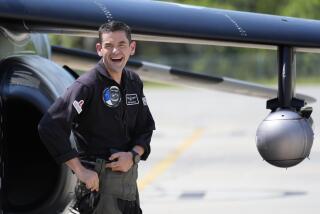Brothers Organizing Up-Close View of Mir’s Re-Entry
WASHINGTON — An American group is organizing a privately sponsored trip to observe what should be a spectacular re-entry of the Russian Mir space station next month as it breaks apart over a remote section of the south Pacific.
The group is led by Bob Citron, founder of SPACEHAB Inc.--a commercial space company--and his brother, Rick, a Los Angeles attorney. They plan to charter a wide-body jet to chase the final, fiery moments of the orbital behemoth as it enters the Earth’s atmosphere after 15 years aloft.
The Citrons, who in the past have organized expeditions to view solar eclipses, hope to sign up 120 people for the flight at an estimated $6,500 per person.
Word of mouth already has brought expressions of interest from 20 people, mostly friends and colleagues, Bob Citron said this week in a telephone interview from his home north of Seattle. Citron is unveiling a Web site, https://mirreentry.com, this week with details on the expedition.
Although the date of the controlled re-entry is not yet known, the Russians are expected to bring Mir down in early to mid-March. An attached Progress cargo vessel will fire its main thruster to push the outpost out of orbit. Most of the Mir complex, which weighs about 135 metric tons, should burn up in the upper atmosphere, specialists said. But the Russians have told NASA officials that at least 21 metric tons of debris are expected to enter the ocean.
Most of the Mir pieces are expected to splash down in a “footprint” about 500 to 1,000 miles long in the remote south Pacific, more than 2,000 miles east of New Zealand.
“On re-entry day, we will travel south of Tahiti about 2,000 miles, more or less, to observe the most significant parts of the breakup phenomena and re-entry,” Citron said. The plane, flying at 30,000 feet, will remain about 200 miles away from the predicted track of the disintegrating Mir, he said.
Besides the paying passengers, Citron said, he expects to offer free seating to about a dozen researchers who would use the chartered aircraft as a platform for telescopes and other instruments to record the Mir re-entry.
Some officials of the National Aeronautics and Space Administration are hoping Citron’s expedition gets images of the Mir re-entry that will help shed light on the re-entry behavior of large space structures.
“We don’t have the budget to deploy our own aircraft,” said Jack Bacon, a NASA engineering official who is gathering data on the demise of Mir as part of an effort to plan the eventual de-orbiting of the new International Space Station. “We’re very interested in Mr. Citron’s efforts.”
Bacon stressed that NASA has no official role in the de-orbiting of Mir. “This is an entirely Russian operation,” he said. But Bacon said the United States will use its defense network of tracking radars to supply the Russians with ballistics data on the Mir breakup. He declined to comment on what other U.S. assets, such as overhead spy satellites, might also be employed to watch Mir’s demise.
A few days before the re-entry, authorities will issue warning advisories for airplanes and ships that may be in the vicinity of the projected debris footprint. Bacon said he is encouraging commercial airline pilots to take along cameras to record any sightings of the Mir breakup. He said it should be visible to aircraft within a few hundred miles of the main debris area. “They will see the white arc in the sky and may see chunks breaking off” the doomed Mir, Bacon said.
More to Read
Sign up for Essential California
The most important California stories and recommendations in your inbox every morning.
You may occasionally receive promotional content from the Los Angeles Times.









